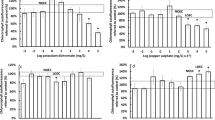Abstract
Three Quebec-based ecotoxicological laboratories participated in an intercalibration exercise to assess the performance of a recently-published cost-efficient algal microplate toxicity assay. Three test series were carried out with six operators (2 from each laboratory) and two reference toxicants (Cd2+ as CdCl2 and phenol). Variables included algal cultivation technique (series 1), presence or absence of Na2EDTA in the growth medium (series 2), and passive or active gas exchange during incubation (series 3). Control growth variability conferred an overall test precision of 8.7% (coefficient of variation obtained for 204 microplate tests). Cadmium (96 h EC50 = 56 µg · l−1) and phenol (96 h EC50 = 69.7 mg · l−1) toxicity test reproducibility was reflected by coefficients of variation of 24.3% and 34.9%, respectively. Algal cultivation technique, whether standardized or ‘in house’, had no effect on toxicity results. Na2EDTA, as part of the growth medium, significantly ameliorated algal growth and toxicity. While active gas exchange during microplate incubation significantly improved growth, toxicity results were unaffected. Phenol volatility was found to have a marked influence on algal growth. This effect can be offset, however, by providing appropriate modifications to better seal individual wells and to improve experimental design.
Similar content being viewed by others
References
Albertano, P., G. Pinto & R. Taddei, 1978. Evaluation of the toxic effects of heavy metals to unicellular algae: the influence of inoculum concentration on the evaluation of toxicity. Delpinoa 20: 76–85.
Bitton, G. & B. Dutka (eds.), 1986. Toxicity testing using microorganisms, volumes I and II. CRC Press, Inc., Boca Raton, Florida, U.S.A., 163 pp. (Volume 1) and 202 pp. (Volume II).
Blaise, C., 1986. Micromethod for acute aquatic toxicity assessment using the green alga Selenastrum capricornutum. Tox. Assess. 1: 377–385.
Blaise, C., R. Legault, N. Bermingham, R. van Coillie & P. Vasseur, 1986. A simple microplate algal assay technique for aquatic toxicity assessment. Tox. Assess. 1: 261–281.
Blaise, C., G. Sergy, P. Wells, N. Bermingham & R. van Coillie, 1988. Biological testing — development, application, and trends in Canadian environmental protection laboratories. Tox. Assess. 3: 385–406.
Blanck, H., G. Wallin & S. A. Wängberg, 1984. Species-dependent variation in algal sensitivity to chemical compounds. Ecotox. Environ. Safe. 8: 339–351.
Chiaudani, G. & M. Vighi, 1978. The use of Selenastrum capricornutum batch cultures in toxicity studies. Mitt. int. Ver. Limnol. 21: 316–329.
Christensen, E. R. & J. Scherfig, 1979. Effects of manganese, copper and lead on Selenastrum capricornutum, Chlorella stigmatophora. Wat. Res. 13: 79–82.
Dive, D., 1981. Nutrition et croissance de Colpidium campylum: contribution expérimentale et possibilités d'application en écotoxicologie. Thése de doctorat présentée à l'Université des Sciences et Techniques de Lille (France), No. 527, 285 pp.
Hassett, J. M., J. C. Jennett & J. E. Smith, 1981. Microplate technique for determining accumulation of metals by algae. Appl. Envir. Microbiol. 41: 1097–1106.
Lukavsky, J., 1983. Evaluation of algal growth potential by cultivation on solid media. Wat. Res. 17: 549–558.
Maciorowski, A. G., J. L. Sims, L. W. Little & E. D. Gerrard, 1980. Bioassays — procedures and results. J. Wat. Pollut. Cont. Fed. 53: 974–993.
Maul, A. & J. C. Block, 1983. Microplate fecal coliform method to monitor stream water pollution. Appl. Envir. Microbiol. 46: 1032–1037.
Miller, W. E., J. C. Greene & T. Shiroyama, 1978. The Selenastrum capricornutum Printz algal assay bottle test: Experimental design, application, and data interpretation protocol. US Environmental Protection Agency Report No. EPA-600/9-78-018, Corvallis, OR, 126 pp.
Sokal, R. R. & F. J. Rohlf, 1981. Biometry. W. H. Freeman & Co., San Francisco, 859 pp.
USEPA (United States Environmental Protection Agency), 1971. The interlaboratory precision test: an eight-laboratory evaluation of the provisional algal assay procedure bottle test. National Eutrophication Research Program, Corvallis, OR, EPA Water Quality Office Project 16010DQT, 70 pp.
Xu, H., B. J. Dutka & K. K. Kwan, 1987. Genotoxicity studies on sediments using a modified SOS Chromotest. Tox. Assess. 2: 79–87.
Author information
Authors and Affiliations
Rights and permissions
About this article
Cite this article
Thellen, C., Blaise, C., Roy, Y. et al. Round Robin testing with the Selenastrum capricornutum microplate toxicity assay. Hydrobiologia 188, 259–268 (1989). https://doi.org/10.1007/BF00027791
Issue Date:
DOI: https://doi.org/10.1007/BF00027791




